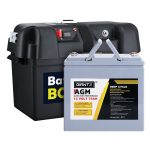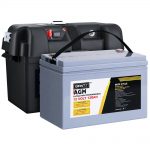
When you need a constant current for a longer period of time, AGM batteries are the ones to go for. These are deep cycle batteries that can provide a current for an extended period of time.
Car batteries, which are flooded lead acid, provide a good burst of current for turning over a motor, but won’t do the distance to keep a fridge or constant draw appliance running. Gel batteries are good, but more expensive ( these other 2 types of lead acid battery are described at the bottom ).
We have a range of 12V AGM batteries, starting from 75 Amp-hours, up to 135Ah ( this is how many amps of current is constantly provided over an hour ). AT the bottom of this page I explain how to use amp-hours to judge the size of battery you need.  The cost of postage is covered by the battery ( or battery and box ) price.
The cost of postage is covered by the battery ( or battery and box ) price.
Deep Cycle Batteries
A deep cycle refers to how low you can drain the charge without damaging their lifespan and before you need to re-charge. Gel, flooded and AGM batteries can all be deep cycle, though AGM has become extremely popular due to lower costs while still having the benefits listed next.
Absorbent Glass Matt (AGM)

The terminals in a lead acid battery are surrounded by sulphuric acid. In older style batteries ( flooded ) the acid can move around and spill out. AGM batteries place a layer of fiberglass mat between the terminals. This soaks up the acid, preventing spills. They are also sealed and these 2 things allow them to safely work on inclined surfaces and under more vibration as well.
AGM batteries work better in low temperatures, charge faster, self-discharge slower and can discharge down to about 20% capacity without damage ( where older ones were about 50% ) which is what the term deep cycle refers to.
If you’d like to study up on the subject there’s a lot of great information at Battery University.
GIANTZ Deep Cycle Batteries are built for 4WD, caravans & campers, boats, all 12V appliances such as portable fridges and washers and any off-the-grid power supply.
They feature an incredible cycle life of up to 1600 cycles, making them some of the most enduring in their class, with longer, consistent and more drawn out charge all the time. These maintenance free batteries are completely sealed, spill-proof and don’t leak gas for added safety.
Deep Cycle Battery & Box Combos

The fully enclosed boxes transform a deep cycle battery into an extremely portable power station.
The boxes provide USB ports and 12V sockets. There’s an on/off switch and voltage display to give you an idea of the current discharge.
Click on one of the models below for more detail.
-
 GIANTZ 12V Battery BoxOriginal price was: $197.95.$149.70Current price is: $149.70.
GIANTZ 12V Battery BoxOriginal price was: $197.95.$149.70Current price is: $149.70. -
 GIANTZ 12V Battery Box (large)Original price was: $222.95.$160.20Current price is: $160.20.
GIANTZ 12V Battery Box (large)Original price was: $222.95.$160.20Current price is: $160.20. -
 GIANTZ 75Ah Deep Cycle Battery & BoxOriginal price was: $587.95.$320.80Current price is: $320.80.
GIANTZ 75Ah Deep Cycle Battery & BoxOriginal price was: $587.95.$320.80Current price is: $320.80. -
 GIANTZ 100Ah Deep Cycle Battery & BoxOriginal price was: $737.95.$370.00Current price is: $370.00.
GIANTZ 100Ah Deep Cycle Battery & BoxOriginal price was: $737.95.$370.00Current price is: $370.00. -
 GIANTZ 120Ah Deep Cycle Battery & BoxOriginal price was: $740.95.$433.20Current price is: $433.20.
GIANTZ 120Ah Deep Cycle Battery & BoxOriginal price was: $740.95.$433.20Current price is: $433.20. -
 GIANTZ 130Ah Deep Cycle Battery & BoxOriginal price was: $757.95.$442.20Current price is: $442.20.
GIANTZ 130Ah Deep Cycle Battery & BoxOriginal price was: $757.95.$442.20Current price is: $442.20. -
 GIANTZ 135Ah Deep Cycle Battery & BoxOriginal price was: $767.95.$468.40Current price is: $468.40.
GIANTZ 135Ah Deep Cycle Battery & BoxOriginal price was: $767.95.$468.40Current price is: $468.40.
How Many Amp Hours Do You Need ?
Amps measure the amount of electrical current you get each hour. So amp hours is just the amount of current you’ve got stored in the battery ( you can use it up all in an hour, or over a day etc ). A 100 Amp hour battery would provide 1 amp per hour for 100 hours.
Work it out like this …
If your fridge-freezer needs 3 amps for 20 minutes each hour, then it will use 1 amp hours each hour & you want it on 24 hours. TV – say 4 amps for 2 hours per day = 8 Amp hours. So 32 Amp hours would be used in a day.
Do this for 2 days away & you’d need about 62 Amp hours. But it’s best not to run down the battery below 50% if you can avoid it, even with a deep cycle battery. So get a 120Ah battery.
Other types of Lead Acid Battery
The 2 other types of deep-cycle, lead acid battery you come across are Flooded Lead Acid ( FLA ) and Gel.
FLA batteries are the more traditional type where lead plate terminals are submerged in sulphuric acid. They require maintenance by topping up the water level and can spill. But can withstand accidental overcharging better than the other 2 and are cheeper.
Gel batteries use a form of silicon to convert the acid to a paste. Like AGM batteries, they’re sealed, maintenance-free and and won’t spill, but of the 3 types, they’re most expensive.
A Basic Maintenance Note
All types of lead-acid batteries will self discharge during storage. Each month, they lose about 10% of their power. So if they aren’t being used regularly, it’s a good idea to top them up with a good charger.
Most regular campers are now using portable solar panels to charge up their batteries each day.













